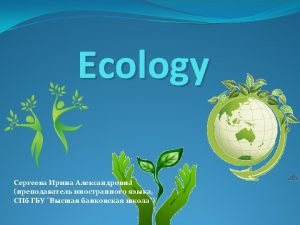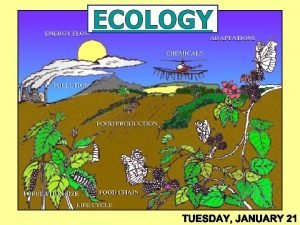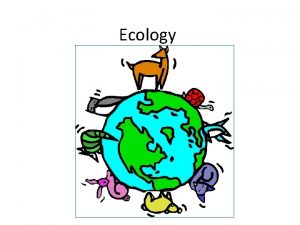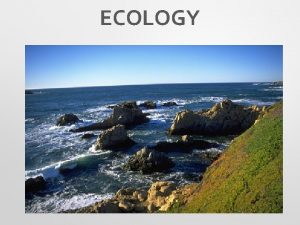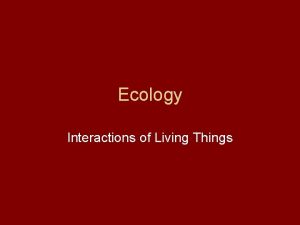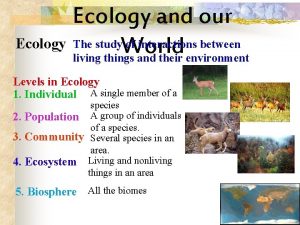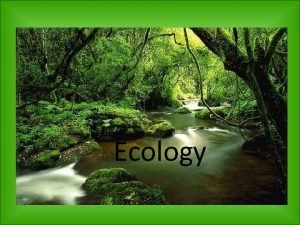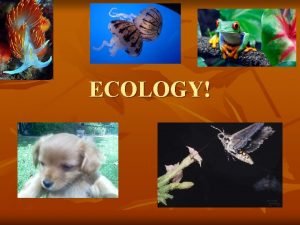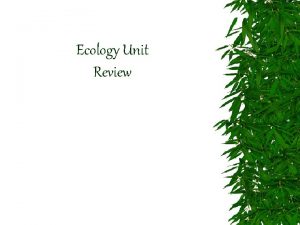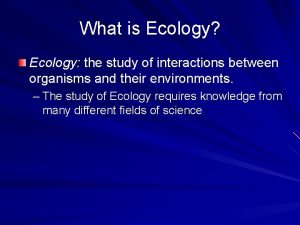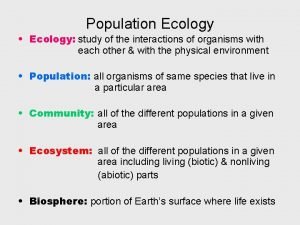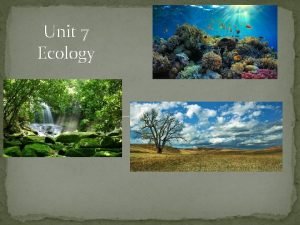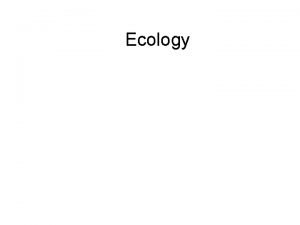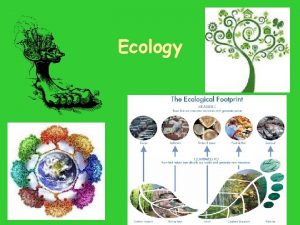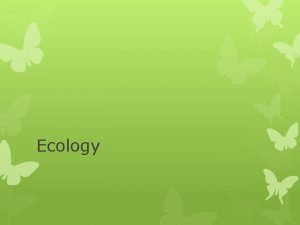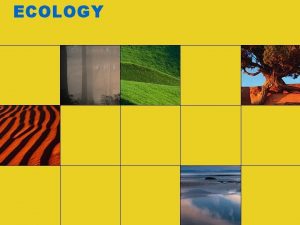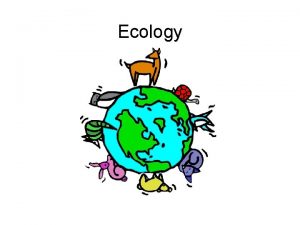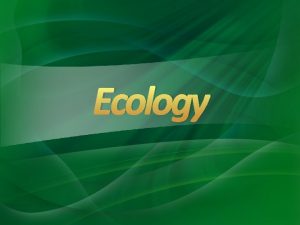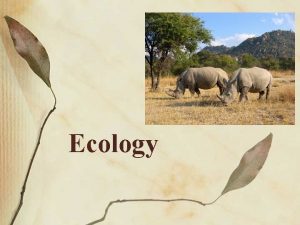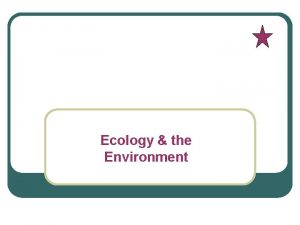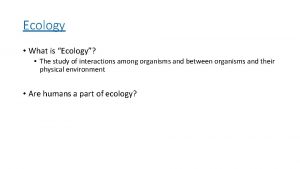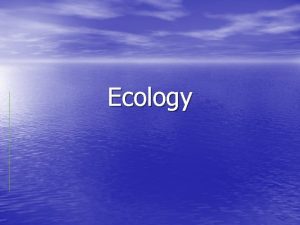Ecology Ecology Study of our interactions with the













































- Slides: 45

Ecology

Ecology • Study of our interactions with the environment (abiotic factors) and each other (biotic factor)

Species • Identical members that can reproduce

Community • Different species living together

Ecosystem • community plus environmental conditions

Main Energy Source THE SUN

Producers • Absorb sunlight to make their own food by the process of photosynthesis. • Also called Autotrophs (plants)

Chemosynthesis • Used in areas with NO sunlight (bacteria)

Consumers • Eat producers or other consumers to get food • Also called Heterotrophs

5 Kinds

1. Herbivores • Eat plants

2. Carnivores • Eat Meat

3. Omnivores • Eat plants and animals

4. Detritivores • Eat Dead Material

5. Decomposers • Recycle Materials back to the soil (Bacteria, Fungi, Insects)

Food chains and Food Webs • ONLY 10% of energy goes to the next level • Start of a food chain is always the producer

Energy Pyramid • Base of energy pyramid is always a producer • Most energy is at the base of the pyramid

Water Cycle • Evaporation- water turning into gas from a body of water. • Transpiration- water turning into gas from plant leaves • BOTH processes put water into the atmosphere

Water Cycle • Condensation- Gas turning to liquid water in the clouds • Precipitation- Liquid water falling back to earth • Both processes put water back on land

Carbon Cycle • Photosynthesis. Takes CO 2 out of the atmosphere • Respiration- Puts CO 2 back into the atmosphere

Nitrogen Cycle • Bacteria “fix” nitrogen and put it back into the soil.

Difference Energy: NOT recycled Nutrients: Recycled

Biotic Factor • Living things that affect us • Plants, animals, etc.

Abiotic Factor • Nonliving things that affect us • Temperature, water, air quality

Habitat • Where you live

Niche • How you live

Two Different species CAN share a habitat, But they CANNOT share a niche.

Symbiosis • Two species living together

Mutualism • Both species benefit • Flower/Bee • Human/Bacteria

Commensalism • One species benefits, the other is unaffected • Whale/barnacle

Parasitism • One species benefits, the other is harmed • Dog/Tick • Humans/Tapeworm

Predator/Prey • One species benefits, the other species dies • Wolf/Rabbit

Populations • Immigration • Moving into a population Emigration ●Moving out of a population ●

Carrying Capacity • Maximum number of individuals an environment can support.

Limiting Factors • Things that limit population growth

Density-dependent • Felt more strongly as population gets bigger • Disease, competition

Density-independent • Felt the same NO matter how big or small the population • Weather, Natural Disasters

Overpopulation • Human population is out of control • Putting TOO much pressure on the earth and its resources

Environmental Issues

Deforestation • Raising CO 2 levels from tree loss • Lack of photosynthesis

Acid Rain • Chemicals from factories combine with water vapor • Fall back to earth as acid rain

Biomagnification • DDT, and other pesticides build up in food chain webs, and harm top consumers • Bald Eagle

Invasive Species • Species get into habitats where they don’t belong, out compete natural species

Ozone layer • CFC’s cause ozone layer to have holes, UV light gets in, causes skin cancer and other types of cancers

Global Warming • High CO 2 levels trap heat, planet warms, causing many problems
 Ecology study guide answers
Ecology study guide answers Study guide chapter 3 section 1 community ecology
Study guide chapter 3 section 1 community ecology Ecology is the study that helps to preserve
Ecology is the study that helps to preserve Thinking language and intelligence
Thinking language and intelligence Our census our future
Our census our future Ok 313
Ok 313 Our life is what our thoughts make it
Our life is what our thoughts make it We bow our hearts we bend our knees
We bow our hearts we bend our knees Our census our future
Our census our future Our life is what our thoughts make it
Our life is what our thoughts make it Money madness short summary
Money madness short summary Awareness of ourselves and our environment is
Awareness of ourselves and our environment is Awareness of ourselves and our environment is
Awareness of ourselves and our environment is God our father christ our brother
God our father christ our brother Our future is in our hands quotes
Our future is in our hands quotes Our awareness of ourselves and our environment
Our awareness of ourselves and our environment Our awareness of ourselves and our environment is called
Our awareness of ourselves and our environment is called Hình ảnh bộ gõ cơ thể búng tay
Hình ảnh bộ gõ cơ thể búng tay Ng-html
Ng-html Bổ thể
Bổ thể Tỉ lệ cơ thể trẻ em
Tỉ lệ cơ thể trẻ em Chó sói
Chó sói Chụp tư thế worms-breton
Chụp tư thế worms-breton Chúa yêu trần thế
Chúa yêu trần thế Môn thể thao bắt đầu bằng từ đua
Môn thể thao bắt đầu bằng từ đua Thế nào là hệ số cao nhất
Thế nào là hệ số cao nhất Các châu lục và đại dương trên thế giới
Các châu lục và đại dương trên thế giới Công thức tính độ biến thiên đông lượng
Công thức tính độ biến thiên đông lượng Trời xanh đây là của chúng ta thể thơ
Trời xanh đây là của chúng ta thể thơ Cách giải mật thư tọa độ
Cách giải mật thư tọa độ Phép trừ bù
Phép trừ bù độ dài liên kết
độ dài liên kết Các châu lục và đại dương trên thế giới
Các châu lục và đại dương trên thế giới Thể thơ truyền thống
Thể thơ truyền thống Quá trình desamine hóa có thể tạo ra
Quá trình desamine hóa có thể tạo ra Một số thể thơ truyền thống
Một số thể thơ truyền thống Bàn tay mà dây bẩn
Bàn tay mà dây bẩn Vẽ hình chiếu vuông góc của vật thể sau
Vẽ hình chiếu vuông góc của vật thể sau Biện pháp chống mỏi cơ
Biện pháp chống mỏi cơ đặc điểm cơ thể của người tối cổ
đặc điểm cơ thể của người tối cổ V cc cc
V cc cc Vẽ hình chiếu đứng bằng cạnh của vật thể
Vẽ hình chiếu đứng bằng cạnh của vật thể Phối cảnh
Phối cảnh Thẻ vin
Thẻ vin đại từ thay thế
đại từ thay thế điện thế nghỉ
điện thế nghỉ


